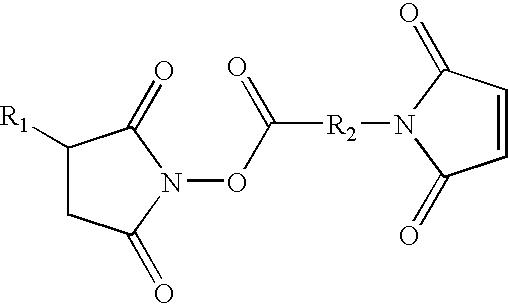Peptide-based conditioners and colorants for hair, skin, and nails
- Summary
- Abstract
- Description
- Claims
- Application Information
AI Technical Summary
Benefits of technology
Problems solved by technology
Method used
Image
Examples
example 1
Selection of Hair-Binding Phage Peptides Using Standard Biopanning
[0312] The purpose of this Example was to identify hair-binding phage peptides that bind to normal hair and to bleached hair using standard phage display biopanning.
[0313] Phage Display Peptide Libraries:
[0314] The phage libraries used in the present invention, Ph.D.-12.TM. Phage Display Peptide Library Kit and Ph.D.-7.TM. Phage Display Library Kit, were purchased from New England BioLabs (Beverly, Mass.). These kits are based on a combinatorial library of random peptide 7 or 12-mers fused to a minor coat protein (pIII) of M13 phage. The displayed peptide is expressed at the N-terminus of pIII, such that after the signal peptide is cleaved, the first residue of the coat protein is the first residue of the displayed peptide. The Ph.D.-7 and Ph.D.-12 libraries consist of approximately 2.8.times.10.sup.9 and 2.7.times.10.sup.9 sequences, respectively. A volume of 10 .mu.L contains about 55 copies of each peptide sequence...
example 2
Selection of High Affinity Hair-Binding Phage Peptides Using a Modified Method
[0325] The purpose of this Example was to identify hair-binding phage peptides with a higher binding affinity.
[0326] The hairs that were treated with the acidic elution buffer, as described in Example 1, were washed three more times with the elution buffer and then washed three times with TBST-0.5%. These hairs, which had acid resistant phage peptides still attached, were used to directly infect 500 .mu.L of mid-log phase bacterial host cells, E. coli ER2738 (New England BioLabs), which were then grown in LB medium for 20 min and then mixed with 3 mL of agarose top (LB medium with 5 mM MgCl.sub.2, and 0.7% agarose) at 45.degree. C. This mixture was spread onto a LB medium / IPTG / S-Gal.TM. plate (LB medium with 15 g / L agar, 0.05 g / L IPTG, and 0.04 g / L S-Gal.TM.) and incubated overnight at 37.degree. C. The black plaques were counted to calculate the phage titer. The single black plaques were randomly picked f...
example 3
Selection of High Affinity Fingernail-Binding Phage Peptides
[0330] The purpose of this Example was to identify phage peptides that have a high binding affinity to fingernails. The modified biopanning method described in Example 2 was used to identify high affinity, fingernail-binding phage-peptide clones.
[0331] Human fingernails were collected from test subjects. The fingernails were cleaned by brushing with soap solution, rinsed with deionized water, and allowed to air-dry at room temperature. The fingernails were then powdered under liquid N.sub.2, and 10 mg of the fingernails was added to each well of a 96-well filter plate. The fingernail samples were treated for 1 h with blocking buffer consisting of 1 mg / mL BSA in TBST-0.5%, and then washed with TBST-0.5%. The fingernail samples were incubated with phage library (Ph.D-12 Phage Display Peptide Library Kit), and washed 10 times using the same conditions described in Example 1. After the acidic elution step, described in Example ...
PUM
| Property | Measurement | Unit |
|---|---|---|
| Length | aaaaa | aaaaa |
| Electric charge | aaaaa | aaaaa |
| Electrical conductance | aaaaa | aaaaa |
Abstract
Description
Claims
Application Information
 Login to View More
Login to View More - R&D
- Intellectual Property
- Life Sciences
- Materials
- Tech Scout
- Unparalleled Data Quality
- Higher Quality Content
- 60% Fewer Hallucinations
Browse by: Latest US Patents, China's latest patents, Technical Efficacy Thesaurus, Application Domain, Technology Topic, Popular Technical Reports.
© 2025 PatSnap. All rights reserved.Legal|Privacy policy|Modern Slavery Act Transparency Statement|Sitemap|About US| Contact US: help@patsnap.com

